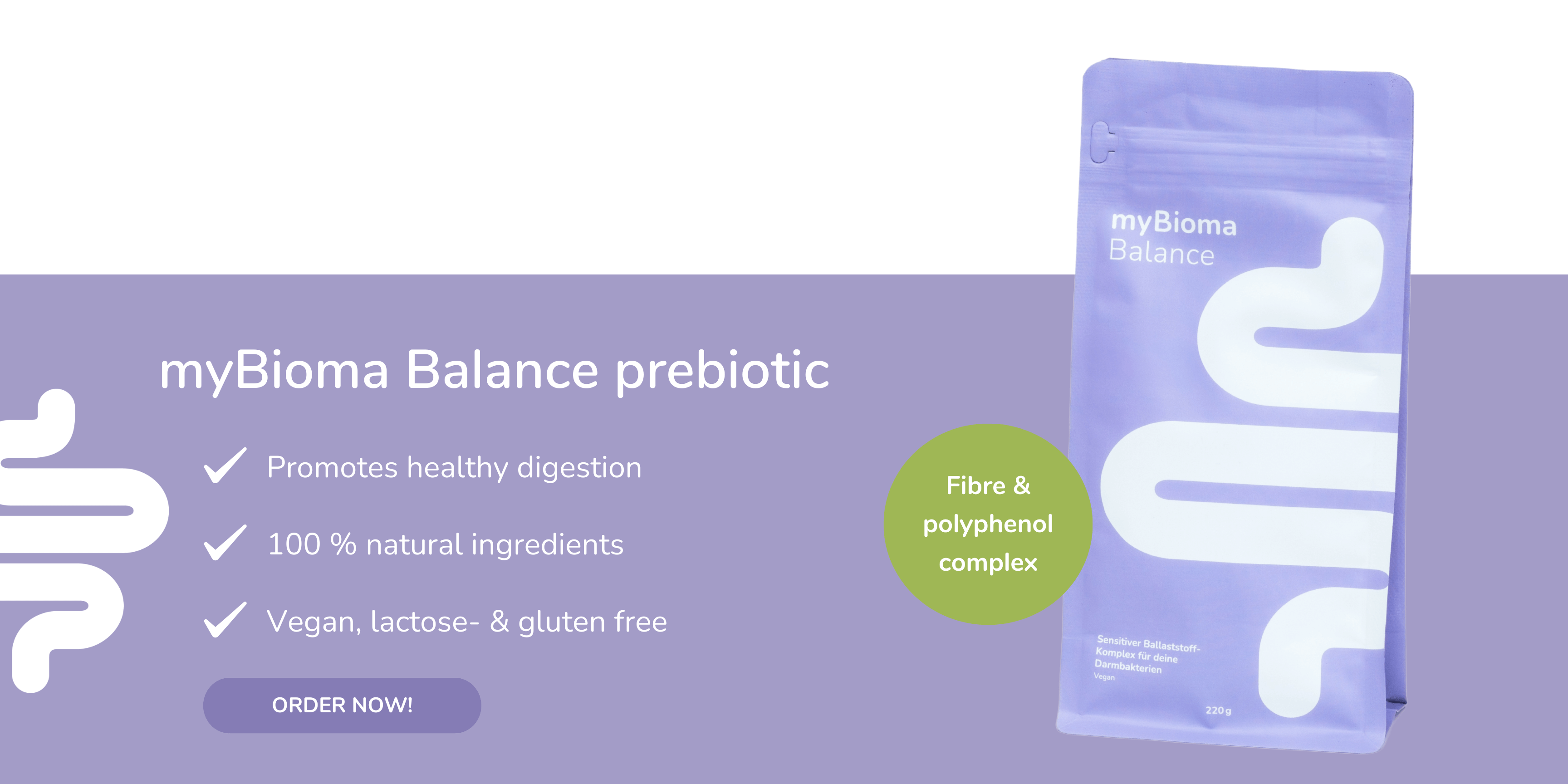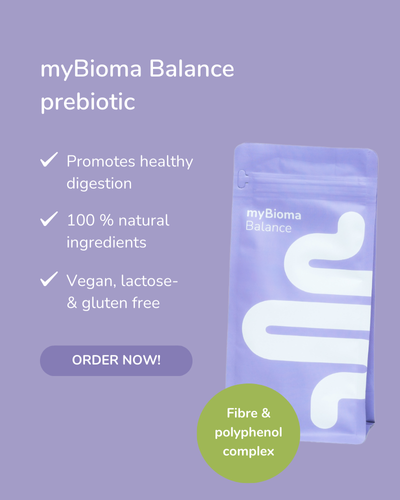Many of us know that our gut microbiome plays a fundamental role in our health and well-being. But did you also know that we need to “feed” the bacteria in our gut? With every food you eat, you decide whether you feed the good or the bad bacteria.
Whether we're exercising, walking the dog, or sitting at a desk, we all need food to keep our bodies functioning. The food we eat every day contains a variety of nutrients such as protein, fat, carbohydrates, vitamins and minerals. Your small intestine is responsible for skillfully breaking down these nutrients into small particles so they can be easily absorbed and used for a variety of body functions.
But which nutrients does our intestinal microbiome need?
It turns out that our intestinal bacteria primarily need protein and carbohydrates to thrive. Intestinal bacteria absorb a specific type of carbohydrate that our body cannot break down: fiber (1)! Fiber is the structural part of plants that is resistant to our digestive juices (2). Scientifically speaking, it is the bonds between the carbohydrate molecules that cannot be broken down by the enzymes available in the small intestine, so that the fiber reaches our large intestine relatively untouched (3). And this is exactly where our good intestinal bacteria come into play.
The intestinal bacteria consume a certain type of carbohydrate that our body cannot break down - fiber (1)!
Deep in your intestines, countless bacteria work tirelessly to break down the substances that hold fiber together. They do this by releasing special enzymes, breaking down fibers into simpler components and releasing the energy potential within. This process is called fermentation (4,5). An end product of fermentation is the formation of short-chain fatty acids (SCFA's) such as butyrate, propionate and acetate (6). Butyrate ensures stability of the intestinal mucosa and keeps the pH value low. It is also believed to have anti-inflammatory properties in our intestines (7).
In general, fiber is classified according to its ability to dissolve in water:
Soluble fiber
Soluble fiber is believed to dissolve in water and form a gel-like substance that can be easily fermented by the gut bacteria. Soluble fiber is mainly found in plant cells. Good sources include apples, bananas and oats (5).
Insoluble fiber
Insoluble fiber refers to the structural parts of plant cell walls that are more resistant to fermentation (5). Good sources are leafy vegetables, legumes or whole grain products.
We now understand that the solubility of fiber in water is not the ideal way to understand the fermentability of fiber. We now focus more on “prebiotic” fiber, which is defined as selectively fermented fiber that supports a healthy microbiome (4).
Common types of prebiotic fiber include:
Resistant starch is created when starchy plant fibers are cooked and allowed to cool again. Potatoes, legumes and rice are important representatives of this. This starch cannot be broken down by the enzymes in the small intestine and so ends up in the large intestine, where it is food for the bacteria there. Resistant starch is found, for example, in sushi, cold boiled potatoes and stews (8).
Fructans are among the best-researched prebiotic fibers. All fructans are basically long chains of fructose molecules. Small chains (2 – 9 molecules) are called FOS (fructooligosaccharides), while longer chains are called inulin. Fructans are found in grains such as wheat, barley and rye, as well as in various fruits and vegetables such as garlic, onions and watermelon. People with irritable bowel syndrome should be careful because fructans may worsen their symptoms (9).
pectin is a structural component in the cell walls of plants that is primarily used as a gelling agent in jam. Pectin has been shown to promote the growth of beneficial bacterial species such as Bifidobacterium longum and Lactobacillus gasseri (10) and is also generally well tolerated by people with irritable bowel syndrome. Foods naturally rich in pectin include apples, plums, and lemons (8).
What happens if we don't eat enough fiber to nourish our intestinal bacteria?
They look for alternative energy sources such as protein or the mucus that protects our intestinal lining. While the human intestine naturally contains bacteria that prefer to break down protein into smaller particles (amino acids) for energy, the metabolic products produced by this type of fermentation can be more inflammatory than those produced by fiber fermentation.
There is still a lot to learn about our gut bacteria and how they can contribute to health - but one thing is clear: a diet rich in plant-based foods provides the fiber needed to positively impact the gut microbiome! Do yourself and your gut microbiome a favor and incorporate more fruits, vegetables, whole grains, nuts, seeds and legumes into your daily diet.
References
- National Health and Medical Research Council (NHMRC). Nutrient Reference Values for Australia and New Zealand. Commonwealth of Australia (2006)
- Food Standards Australia and New Zealand. Standard 1.1.2 – Definitions used throughout the Code Canberra: FSANZ (2006)
- DeVries, J. W. On defining dietary fibre. Proceedings of the Nutrition Society, 62(1), 37-43 (2003). Doi: 10.1079/PNS2002234
- Slavin, J. Fiber and prebiotics: mechanisms and health benefits. Nutrients, 5(4), 1417-1435 (2013). Doi: 10.3390/nu5041417
- Williams, B., Grant, L., Gidley, M., & Mikkelsen, D. Gut fermentation of dietary fibres: physico-chemistry of plant cell walls and implications for health. International journal of molecular sciences, 18(10), 2203 (2017). Doi: 10.3390/ijms18102203
- Ríos-Covián, D., Ruas-Madiedo, P., Margolles, A., Gueimonde, M., de los Reyes-Gavilán, C. G., & Salazar, N. Intestinal short chain fatty acids and their link with diet and human health. Frontiers in microbiology, 7, 185 (2016). Doi: 10.3389/fmicb.2016.00185
- Cushing, K., Alvarado, D. M., & Ciorba, M. A. Butyrate and mucosal inflammation: new scientific evidence supports clinical observation. Clinical and translational gastroenterology, 6(8), e108 (2015). Doi: 10.1038/ctg.2015.34
- Stephen, A. M., Champ, M. M. J., Cloran, S. J., Fleith, M., Van Lieshout, L., Mejborn, H., & Burley, V. J. Dietary fibre in Europe: current state of knowledge on definitions, sources, recommendations, intakes and relationships to health. Nutrition research reviews, 30(2), 149-190 (2017). Doi: 10.1017/S095442241700004X
- Wilson, B., & Whelan, K. Prebiotic inulin‐type fructans and galacto‐oligosaccharides: definition, specificity, function, and application in gastrointestinal disorders. Journal of gastroenterology and hepatology, 32, 64-68 (2017). Doi: 10.1111/jgh.13700
- Shinohara, K., Ohashi, Y., Kawasumi, K., Terada, A., & Fujisawa, T. Effect of apple intake on fecal microbiota and metabolites in humans. Anaerobe, 16(5), 510-515 (2010). Doi: 10.1016/j.anaerobe.2010.03.005










